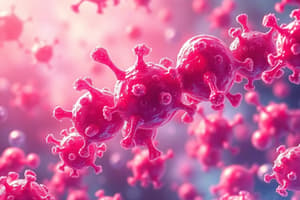Podcast
Questions and Answers
Which of the following is recognized for hearing impairment as a side effect?
Which of the following is recognized for hearing impairment as a side effect?
- Erythromycin
- Ceftriaxone
- Clindamycin
- Streptomycin (correct)
Which of the following affects the cell wall?
Which of the following affects the cell wall?
- Gentamicin
- Ceftriaxone (correct)
- Azithromycin
- Chloramphenicol
Which of the following affect the bacterial cell wall?
Which of the following affect the bacterial cell wall?
- Polymyxins (correct)
- Macrolides
- Aminoglycosides
- Cephalosporins (correct)
What is the impact of antimicrobial resistance on health?
What is the impact of antimicrobial resistance on health?
What is antimicrobial stewardship?
What is antimicrobial stewardship?
What is an antimicrobial agent?
What is an antimicrobial agent?
Define antibiotics.
Define antibiotics.
What is selective toxicity?
What is selective toxicity?
The ______ is the ratio of toxic dose to therapeutic dose.
The ______ is the ratio of toxic dose to therapeutic dose.
Which of the following tests measures the lowest concentration of drug that prevents growth?
Which of the following tests measures the lowest concentration of drug that prevents growth?
List one factor that influences the effectiveness of antimicrobial agents.
List one factor that influences the effectiveness of antimicrobial agents.
What does a broad-spectrum antibiotic do?
What does a broad-spectrum antibiotic do?
All antibiotics kill bacteria.
All antibiotics kill bacteria.
What is the purpose of the Kirby-Bauer Disk Diffusion Test?
What is the purpose of the Kirby-Bauer Disk Diffusion Test?
Which of the following is a mechanism of antibiotic resistance?
Which of the following is a mechanism of antibiotic resistance?
What happens during antibiotic antagonism?
What happens during antibiotic antagonism?
Match the following antibiotics with their mechanisms of action:
Match the following antibiotics with their mechanisms of action:
What are beta-lactam antibiotics known for?
What are beta-lactam antibiotics known for?
What is the role of plasmids in bacteria?
What is the role of plasmids in bacteria?
Antibiotic overuse can create a selective environment for resistant strains.
Antibiotic overuse can create a selective environment for resistant strains.
What is empiric therapy?
What is empiric therapy?
Flashcards are hidden until you start studying
Study Notes
Introduction to Antimicrobial Agents
- Antimicrobial agents kill or inhibit the growth of susceptible organisms, encompassing anti-viral and anti-protozoal actions.
- Antibiotics are produced by microorganisms or chemically synthesized, capable of inhibiting microbial growth at low concentrations.
- Chemotherapy selectively targets invading microbes or abnormal cells.
History
- Fleming's 1945 Nobel Prize speech warned about the potential for antibiotic resistance if antibiotics became easily accessible and misused.
General Characteristics of Antimicrobial Agents
- Selective toxicity minimizes harm to the host while effectively targeting microbes.
- Therapeutic index (ratio of toxic dose to therapeutic dose) indicates the safety margin of an antibiotic; a larger index is preferable.
- Antimicrobials can be classified by range of effectiveness: narrow-spectrum (specific target) and broad-spectrum (variety of targets).
- Bactericidal agents kill microbes, while bacteriostatic agents inhibit their growth.
Measurement of Activity
- Minimum Inhibitory Concentration (MIC) is the lowest concentration that prevents microbe growth.
- Minimum Lethal Concentration (MLC) is the lowest concentration that kills microbes.
- Susceptibility testing methods include dilution tests and disk diffusion tests (e.g., Kirby-Bauer).
Factors Affecting Effectiveness
- Route of administration (oral, topical, parenteral) influences the drug’s effectiveness.
- The site of infection’s accessibility, drug stability in the body, and the pathogen’s susceptibility impact treatment success.
- Drug concentrations at the infection site must exceed the MIC for effectiveness.
Antibiotic Spectrum and Combinations
- Broad-spectrum antibiotics fight various gram-positive and gram-negative bacteria, while narrow-spectrum ones focus on specific organisms.
- Combination therapies can broaden the antibacterial spectrum, prevent resistant strains, and enhance killing effects through synergism.
- Antibiotic antagonism occurs when one drug reduces the effectiveness of another.
Classification of Antimicrobial Agents
- Antimicrobials are categorized based on therapeutic use (e.g., antibacterial, antifungal, antiviral), mechanism of action, spectrum of activity, and source.
- Common antibacterial agents include Penicillin, Chloramphenicol, and Tetracyclines; antifungals include Amphotericin B and Ketoconazole.
Mechanisms of Action
- Antimetabolite Action: Sulfonamides and trimethoprim interfere with folic acid synthesis in bacteria.
- Alteration of Cell Membranes: Polymyxins disrupt membrane integrity, mostly used topically due to toxicity.
- Inhibition of Protein Synthesis: Targets include the 30S and 50S ribosomal subunits; aminoglycosides and macrolides are key examples.
- Inhibition of DNA/RNA Synthesis: Rifampin and quinolones prevent bacterial replication by affecting RNA polymerase and DNA gyrase, respectively.
- Cell Wall Synthesis Inhibitors: Includes β-Lactam antibiotics like penicillins and cephalosporins, which disrupt peptidoglycan cross-linking.
Antimicrobial Resistance
- Antibiotic resistance arises when bacteria continue to multiply despite antibiotic treatment.
- Resistance mechanisms include drug inactivation, drug efflux, altered target sites, and decreased permeability.
- Resistance can be inherited or acquired through mutation, plasmids, or genetic transfer between bacteria.
Factors Contributing to Resistance
- Overuse of antibiotics and inappropriate prescriptions promote the survival of resistant strains.
- Suboptimal levels of antibiotics and the use of broad-spectrum drugs enhance selective pressure on pathogens.
- Poor hygiene, use of antibiotics in agriculture, and patient compliance issues also contribute to increased resistance.
Inappropriate Antibiotic Use
- Misuse includes using broad-spectrum antibiotics unnecessarily, inappropriate drug regimens, and not following established guidelines.
- Initiating therapy ideally involves culturing the infection site to determine the causative organism before prescribing antibiotics. Empiric therapy is commonly practiced when exact information is pending.
Current Situation and Challenges
- Misdiagnosis and underutilization of laboratory testing in Africa exacerbate antibiotic resistance issues.
- Factors beyond health worker control (e.g., over-the-counter antibiotics, counterfeit drugs) complicate the situation and promote improper use.
- Guidelines for antibiotic use are frequently ignored, leading to a higher risk of resistant infections.### Antibiotic Resistance Patterns
- Gentamicin demonstrates high effectiveness with resistance rates reaching 100% in some cases.
- Amikacin shows an overall resistance of 0% to Meropenem and persists at 100% effectiveness in certain contexts.
- Ciprofloxacin exhibits variable resistance, 53.1% in E. coli; lower in Klebsiella at 43.2%.
- Ceftriaxone shows high resistance in both E. coli (81.3%) and Klebsiella (78.5%).
- Ampicillin presents severe resistance levels of 97.8% in E. coli and 94.5% in Klebsiella, signifying limited treatment options.
Impact of Antimicrobial Resistance (AMR)
- AMR leads to longer illness duration, which complicates recovery and increases healthcare burdens.
- Patients infected with resistant strains face a higher mortality rate and require more expensive treatments.
- Technological advances in healthcare, like complex surgeries or transplants, are undermined due to resistant infections.
- Patients can act as reservoirs of resistant organisms, which may spread to the community and healthcare workers.
Strategies to Combat Antibiotic Resistance
- Avoid antibiotics for viral infections to prevent misuse and resistance development.
- Complete full doses of prescribed antibiotics to avoid incomplete treatment.
- Utilize combinations of drugs for bacterial infections to enhance effectiveness.
- Encourage reduction or elimination of preventive antibiotic use in livestock and crops.
Antimicrobial Stewardship
- A multi-disciplinary approach aims to reduce patient morbidity and the spread of AMR.
- Strategies include:
- Education and guidelines for responsible antibiotic use.
- Formulary restrictions to manage antibiotic prescriptions.
- Audits with feedback to ensure compliance with antibiotic stewardship.
Importance of Preservation
- Recognizing antibiotics as a precious resource emphasizes the necessity for collective efforts in AMR management.
- Immediate action in combating AMR is crucial to ensure future treatment efficacy.
Quiz Questions
- Hearing impairment as a side effect is recognized for: A. Streptomycin
- Antibiotics affecting the cell wall include: A. Ceftriaxone
- Substances affecting bacterial cell walls encompass: C. Cephalosporins
Studying That Suits You
Use AI to generate personalized quizzes and flashcards to suit your learning preferences.




